"Being born in a duck yard does not matter, if only you are hatched from a swan's egg." -Hans Christian Anderson
Welcome back for another Messier Monday! There are 110 deep-sky objects in the Messier catalogue, some of the most prominent night-sky fixtures, as seen from Earth, running the gamut of astronomical phenomena from within our galaxy and beyond. Each week, we pick a new one to place under the spotlight, examining what it is, what we know about it, and how to find it, among other spectacular facts.
 Image credit: Rolando Ligustri, taken over many years, retrieved from http://www.itelescope.net/.
Image credit: Rolando Ligustri, taken over many years, retrieved from http://www.itelescope.net/.
This week, we're taking a look at one of the most prominent star clusters in all of the night sky: the Wild Duck Cluster, Messier 11. If you look towards the southern part of the sky after sunset, you'll be able to find this gem, located right in the plane of our galaxy.
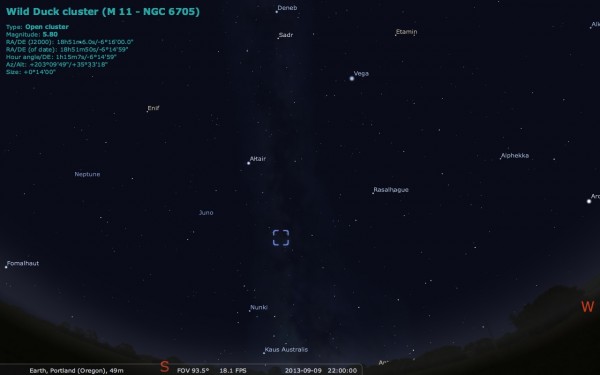 Image credit: me, using the free software Stellarium, via http://stellarium.org/.
Image credit: me, using the free software Stellarium, via http://stellarium.org/.
Looking low above the southern horizon shortly after sunset, you might recognize the teapot asterism in Sagittarius. Looking high above the horizon, you'll see the familiar Summer Triangle, with Altair coming closest to the southern horizon. And if you've got dark enough skies after the Moon goes down, you'll even see the disk of the Milky Way form a line connecting the triangle with the spout of the teapot.
If you want to find Messier 11, look halfway between Altair and the teapot, and there will be some stars to help guide you.
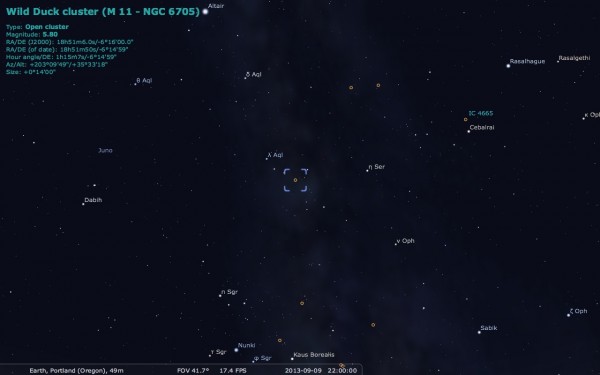 Image credit: me, using the free software Stellarium, via http://stellarium.org/.
Image credit: me, using the free software Stellarium, via http://stellarium.org/.
The blue star, λ Aquilae, is an unspectacular star as seen from Earth, but it outshines all the others in its vicinity. Just slightly to the southwest of it, you can see another prominent star, 12 Aquilae, and then yet another, η Scuti. Head just a little farther in the same general direction, and you won't be able to miss a bright, fuzzy collection of stars: that's Messier 11, the Wild Duck Cluster.
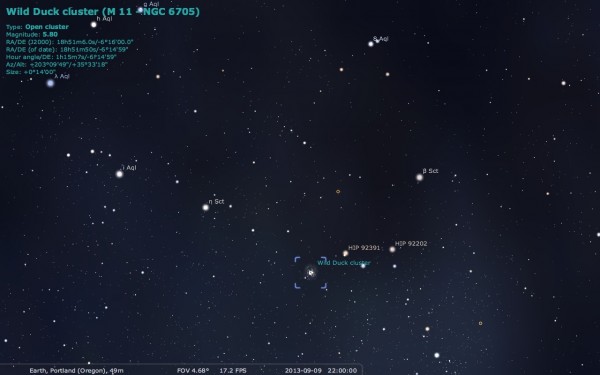 Image credit: me, using the free software Stellarium, via http://stellarium.org/.
Image credit: me, using the free software Stellarium, via http://stellarium.org/.
What would this look like with an actual, wide-field astrophotography setup? Thanks to Stephen Rahn, you can see for yourself!
That fuzzy guy in the middle of the photo above is Messier 11, and it's actually -- though just barely -- visible to the naked eye. Of the open star clusters visible from Earth, this is one of the most compact, densest, and richest of them all!
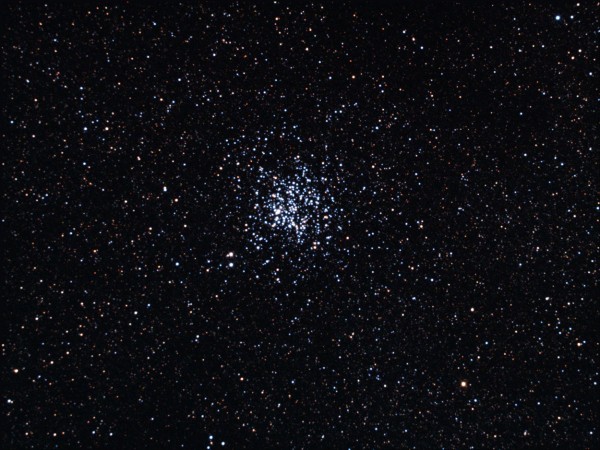 Image credit: Dean Jacobsen of http://www.astrophoto.net/.
Image credit: Dean Jacobsen of http://www.astrophoto.net/.
Open star clusters form from the collapse of a molecular cloud of gas, typically form a few hundred to a couple thousand stars, then gravitationally dissociate over a time period of a few hundred million years to a billion years or so.
Well, Messier 11 is definitely on the heavy side of this!
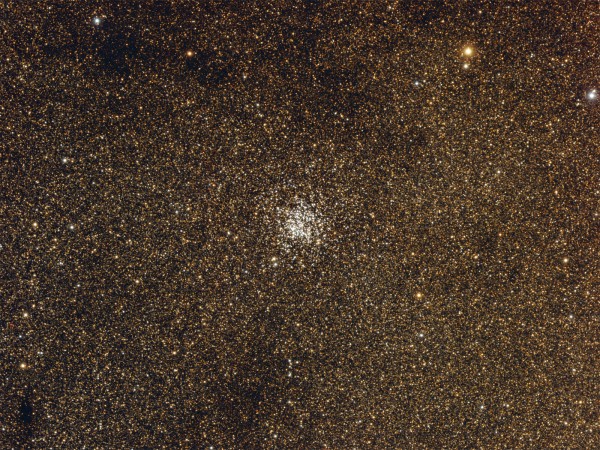 Image credit: Bernhard Hubl of http://astrophoton.com/.
Image credit: Bernhard Hubl of http://astrophoton.com/.
With at least 2,900 stars inside and at a somewhat advanced age of 220-250 million years, this is known as the Wild Duck Cluster because the brightest stars, as viewed through a low-power telescope, appear to take on the V-shaped silhouette of a flock of flying ducks!
In reality, a close-up shows a much more complicated structure to the stars inside.
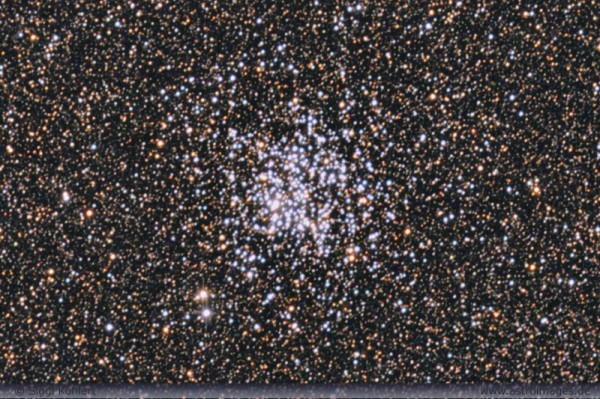 Image credit: © 2006 - 2012 by Siegfried Kohlert, via http://www.astroimages.de/.
Image credit: © 2006 - 2012 by Siegfried Kohlert, via http://www.astroimages.de/.
A rich mix of blue, yellow and red stars lie inside, with the blue and yellow ones shining most brightly. This is another particular difficult cluster to count the exact number of stars in, as it's difficult to tell what's a background star from the galactic plane and what's a dimmer, redder star that's natural to the cluster.
But the bright yellow-and-red ones are giant stars: stars that have run out of hydrogen fuel in their core and have expanded to become giants, much like our Sun will.
Only, the Sun will take 10-to-12 billion years to do this, while this cluster has only had enough time for most of the B-class stars to run out of fuel in their core. The brightest main sequence star in there -- or star still burning hydrogen -- is class B8, which is the second-faintest B-class star that there is. (The brightest star overall is a rare white giant star, a temporary stage in the life of a dying red giant star!)
There are also some 82 variable stars in this cluster, which helps us learn about its properties like its distance, age and evolution.
It's about 6,000 light-years away from us, which is a pretty large distance for an open cluster; in fact, it's the most distant open cluster in the entire Messier catalogue that's still visible to the naked eye!
The first Hubble images of this object were only taken last month, and as such, they're not yet available. (Unfortunately!)
But if we can get some good resolution images, you can see beyond the brightest stars that all seem to blur together, and the rich, dimmer stars that will continue to shine long after the brighter ones burn out.
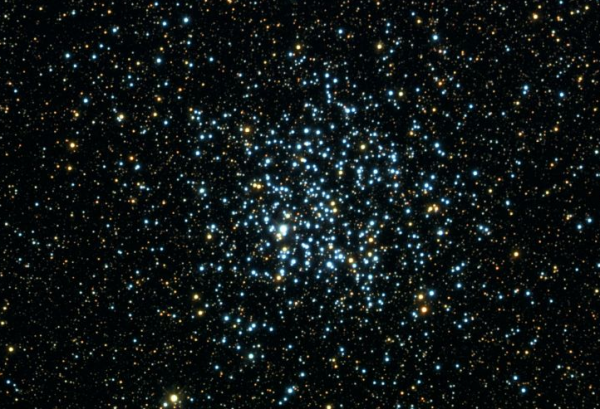 Image credit: WikiSky, via http://tinyurl.com/messier11-Wiki.
Image credit: WikiSky, via http://tinyurl.com/messier11-Wiki.
In the infrared, the cooler, redder stars shine far more brightly, and many more become prominently visible, as this 2MASS image shows.
The best-resolution look inside this cluster I've seen comes from Jim Misti, where you can really see the detail of what lies behind the brightest stars in this cluster. As you can note for yourself, it seems like the only limit to the number of stars we see is how long of an exposure we're willing to take!
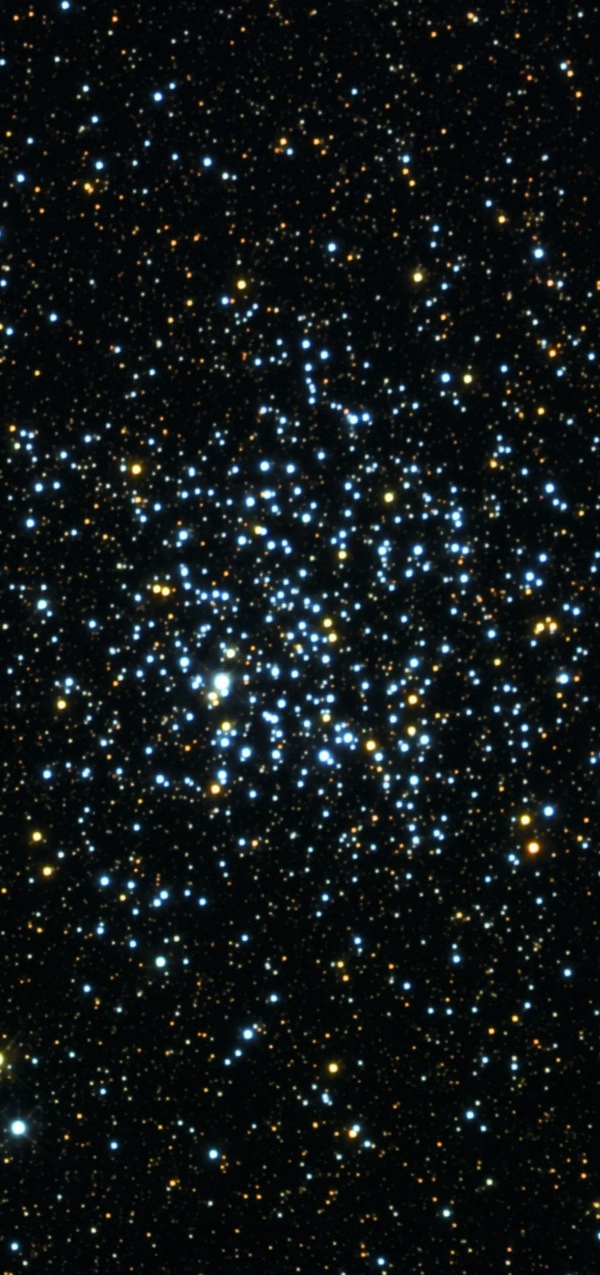 Image credit: Jim Misti of Misti Mountain Observatory, via http://www.mistisoftware.com/.
Image credit: Jim Misti of Misti Mountain Observatory, via http://www.mistisoftware.com/.
Over the next few hundred million years, these stars will fly apart due to gravitational interactions, the bluest ones will run out of fuel, become giants, and die in planetary nebulae/white dwarfs, while the lower-mass ones will eventually become strewn about our galaxy, becoming nothing more than ordinary, nondescript stars that live in the Milky Way's disk: the fate of all open star clusters!
And that will wrap up another Messier Monday! Including today’s entry, we’ve taken a look at the following Messier objects:
- M1, The Crab Nebula: October 22, 2012
- M2, Messier’s First Globular Cluster: June 17, 2013
- M5, A Hyper-Smooth Globular Cluster: May 20, 2013
- M7, The Most Southerly Messier Object: July 8, 2013
- M8, The Lagoon Nebula: November 5, 2012
- M11, The Wild Duck Cluster: September 9, 2013
- M12, The Top-Heavy Gumball Globular: August 26, 2013
- M13, The Great Globular Cluster in Hercules: December 31, 2012
- M15, An Ancient Globular Cluster: November 12, 2012
- M18, A Well-Hidden, Young Star Cluster: August 5, 2013
- M20, The Youngest Star-Forming Region, The Trifid Nebula: May 6, 2013
- M21, A Baby Open Cluster in the Galactic Plane: June 24, 2013
- M25, A Dusty Open Cluster for Everyone: April 8, 2013
- M29, A Young Open Cluster in the Summer Triangle: June 3, 2013
- M30, A Straggling Globular Cluster: November 26, 2012
- M31, Andromeda, the Object that Opened Up the Universe: September 2, 2013
- M33, The Triangulum Galaxy: February 25, 2013
- M37, A Rich Open Star Cluster: December 3, 2012
- M38, A Real-Life Pi-in-the-Sky Cluster: April 29, 2013
- M40, Messier’s Greatest Mistake: April 1, 2013
- M41, The Dog Star’s Secret Neighbor: January 7, 2013
- M44, The Beehive Cluster / Praesepe: December 24, 2012
- M45, The Pleiades: October 29, 2012
- M48, A Lost-and-Found Star Cluster: February 11, 2013
- M51, The Whirlpool Galaxy: April 15th, 2013
- M52, A Star Cluster on the Bubble: March 4, 2013
- M53, The Most Northern Galactic Globular: February 18, 2013
- M56, The Methuselah of Messier Objects: August 12, 2013
- M57, The Ring Nebula: July 1, 2013
- M60, The Gateway Galaxy to Virgo: February 4, 2013
- M65, The First Messier Supernova of 2013: March 25, 2013
- M67, Messier’s Oldest Open Cluster: January 14, 2013
- M71, A Very Unusual Globular Cluster: July 15, 2013
- M72, A Diffuse, Distant Globular at the End-of-the-Marathon: March 18, 2013
- M74, The Phantom Galaxy at the Beginning-of-the-Marathon: March 11, 2013
- M78, A Reflection Nebula: December 10, 2012
- M81, Bode’s Galaxy: November 19, 2012
- M82, The Cigar Galaxy: May 13, 2013
- M83, The Southern Pinwheel Galaxy, January 21, 2013
- M86, The Most Blueshifted Messier Object, June 10, 2013
- M92, The Second Greatest Globular in Hercules, April 22, 2013
- M94, A double-ringed mystery galaxy, August 19, 2013
- M97, The Owl Nebula, January 28, 2013
- M99, The Great Pinwheel of Virgo, July 29, 2013
- M102, A Great Galactic Controversy: December 17, 2012
- M104, The Sombrero Galaxy: May 27, 2013
- M108, A Galactic Sliver in the Big Dipper: July 22, 2013
Come back next week, where we'll have another object for you to find and enjoy in the night sky, and another great cosmic story to tell. Happy Messier Monday!

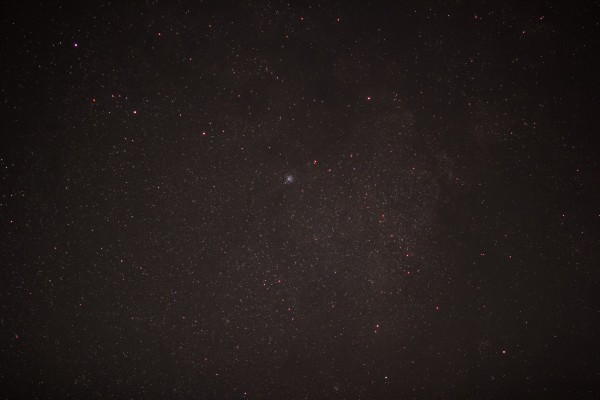
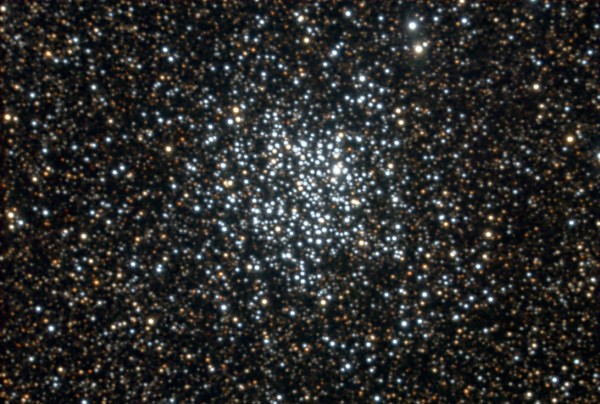
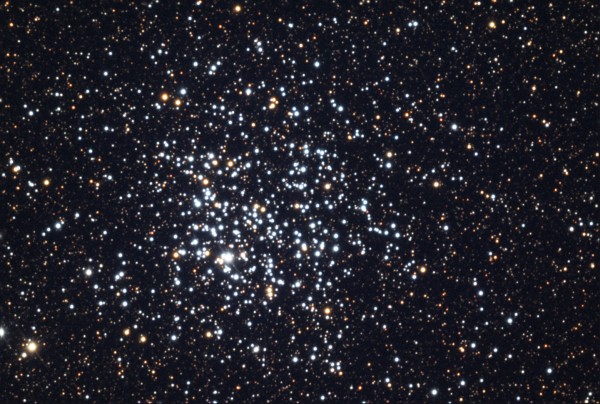
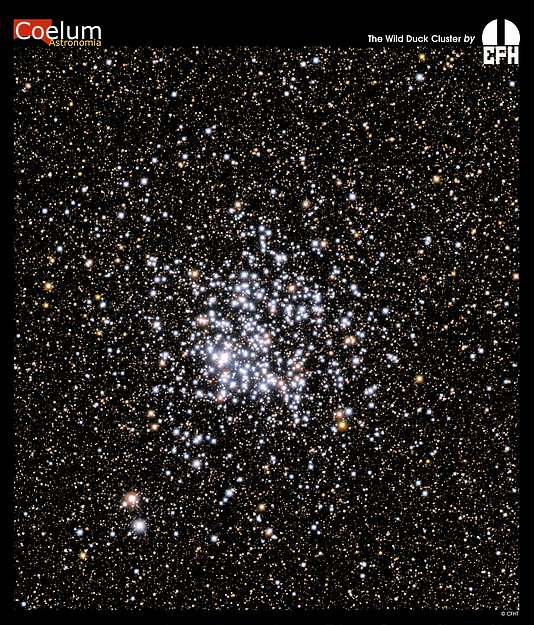
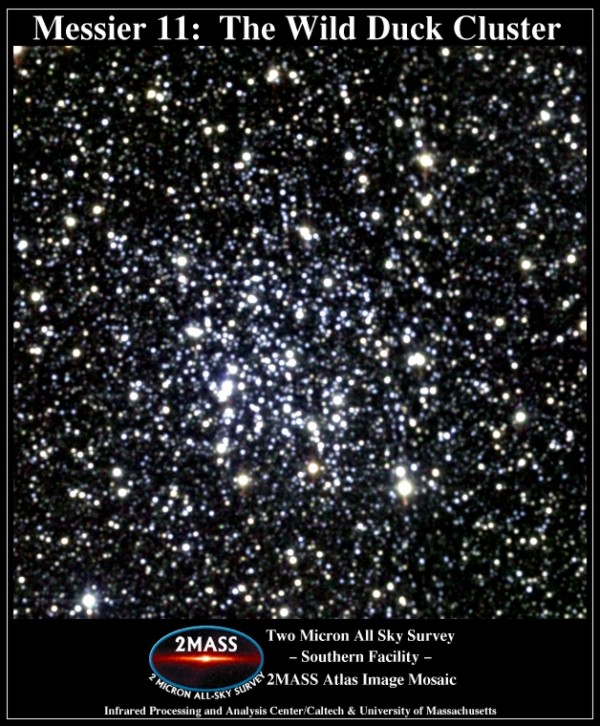
Hi Ethan,
"There are also some [...] variable stars in this cluster, which helps us learn about its properties like its distance, age and evolution."
Perhaps, could you somewhen explain this a bit deeper, somehow like the insight into an astronomer's work?
Thanks a lot in advance.
Hi Ethan,
"Over the next few hundred million years, these stars will fly apart due to gravitational interactions"
Shouldn't there exist a lot of such clusters just being in process of dissolving? Perhaps one can sort all these clusters related to their grade of dissolution?
Well distance is simple and you probably already know it: standard candles. Variables, depending on why they vary, have an extemely fine balance of forces to be variable and a tiny change in that balance makes the variation very different.
So variables of various kinds are used as standard candles.
When a star is evolving from a main sequence to a giant stage, the changeover happens (cosmically speaking) extremely rapidly and the brightness (therefore mass) of the variable is known to a decent accuracy and therefore the time taken to change is well constrained. That gives the age.
The dissolution of gas works better for very young clusters and dispersion of the open cluster puts a minimum age, and is only approximate (but better than nothing). So other methods are possible, but have their limitations.
I'm not entirely sure about the evolution, however.
ATL formulae, diagrams and much more wording can be used, but that's a very basic outline.
PS Open cluster categorisation is already done:
http://en.wikipedia.org/wiki/Open_cluster#Morphology_and_classification
@Wow (#3):
Thanks a lot!
By the way: What are "ATL formulae"? (AgeToLuminosity?? ;-)) Do you have any links for deeper-interested?
It is very interesting that ALL open clusters have a 3-4 ly diameter and up to 20 ly halo with decreasing density.
It seems as if there exists a so far undetected law -- I think, this is usually compensated with related amount of Dark Matter, different from cluster to cluster, right?
Above The Line, SL
It's a term for blogcomments by the blog owner in the post, whereas formatting restrictions in the blog entries added in the comments mean you cannot get the same information density.
The size of that open cluster is based on the fact that star formation has to occur when a cloud collapses and has to have enough mass to create at least one sun (and generally lots more) and has to concentrate that with gravitic infall from that cloud to the centre of mass, which has to fall in by the time ignition happens because at that point, any gas still not condensed enough will be blown away and no longer able to fall in.
And it seems in the milky way, with the dust density it has, gives ~3-4 light years to get enough stellar material to go boom and small enough to collapse before the boom goes boom.
(I apologise for these technical terms. :-) )
Dark matter won't have any discernable effect given the limitations its ideology requires it to have to explain the phenomena it's created to explain.
I'm afraid for more you'd be better off looking yourself in University libraries on Stellar Physics, the mechanisms start being introduced in Astrophysics courses in the second year of a BSc course and the papers you'd find in a Google Scholar search would give you far too cutting an edge on the idea.
The rough statements I gave in #3 are a potted version of what you can find in popular literature on the subject, for more this may help (sight unseen, but seems appropriate):
http://www.amazon.co.uk/Stellar-Evolution-Physics-Volume-2/dp/1107016576